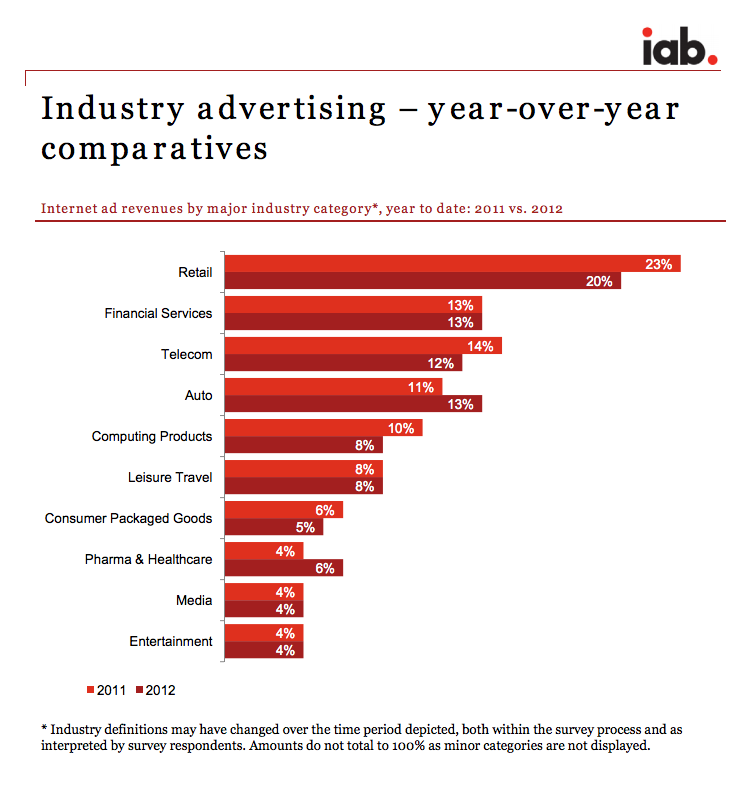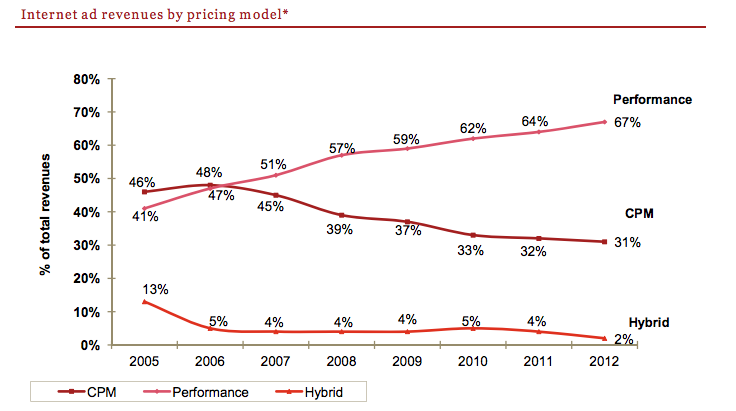In the first half of 2012, digital ad revenue climbed to an all-time high of $17B with Q1 accounting for approximately $8.3B and Q2 $8.7B. Combined, this represents a 14% increase, compared to the first two quarters of 2011, according to the IAB Internet Advertising Revenue Report released by the Interactive Advertising Bureau (IAB). The not-so-great-part is that half-year growth has declined from 23% between 2010 to 2011 to 14% between 2011 and 2012, indicating that digital ad spend may finally be slowing down. Chief research officer at Kantar Media North America Jon Swallen writes, “Ad spending growth sputtered during the second quarter and was unable to sustain its early year momentum,” and that, “The advertising market is mirroring the tepid, slow growth performance of the general economy.” Despite this, online advertising continues to show strong growth in certain segments.
Other highlights from the report include:
- Mobile advertising increased 95% in the first six months of 2012 going from $636M (2011’s half year amount) to $1.2B. Mobile represents about 7% of online ad spend, which is still relatively small.
- Display-related advertising (e.g., display/banner ads, rich media, digital video and sponsorship) revenues in the first half of the year totaled almost $5.6B, accounting for 33% of 2012 half-year revenues, up 4% from $5.3B in the first half of 2011.
- Ad spending increased on TV 4.4% in Q2 of 2012, 2.5% for outdoor media and 1.9% for radio, according to Kantar.
- Display ads for online publications, were less successful than all of the above. Advertising revenue declined 1.9% for local newspapers, 2.6% for consumer magazines, 5.4% for display ads online and a whopping 10.7% for national newspapers.
- Despite an overall decline of about 4%, retail advertisers constitute the largest category of Internet ad spending for the first half of this year, claiming 20% total revenue at $3.4B.
- Consistent year-over-year, performance-based pricing (CPC) remains the preferred model over impression (CPM) and hybrid models.
David Silverman, a partner at PricewaterhouseCoopers, writes, “The tremendous growth of mobile advertising revenue over the past year is an indication of the importance of location to advertisers and mobility to consumers. Bringing the power of the Internet to mobile devices has opened up a world of possibilities to both consumers and marketers.” But while the IAB and others continue to tout digital ad growth by citing its progress relative to other mediums, the majority of ad dollars are still spent offline. In 2011, newspapers and magazines yielded $35.8B in offline ad revenue. Whether or not online ad spend exceeds print media by the end of this year is anyone’s guess, but it almost certainly will at some point in the next few years. In any case, it’ll definitely take a lot longer for it to surpass TV as it accrued nearly $75B in ad dollars in 2011.
Photo Credits: Interactive Advertising Bureau (IAB), Womensmarketing.com

